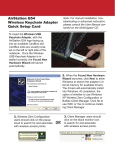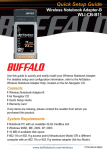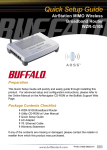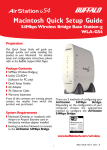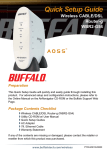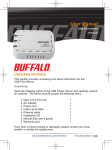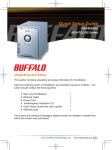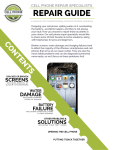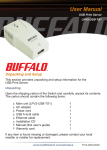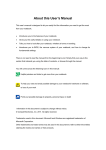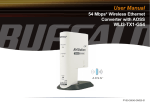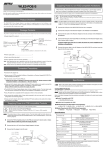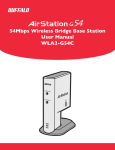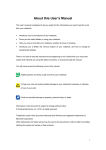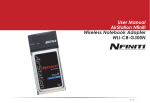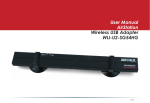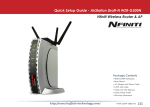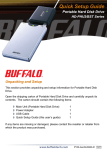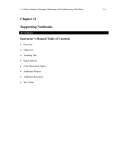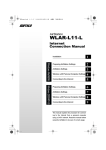Download Quick Setup Guide
Transcript
® Quick Setup Guide 54Mbps Wireless Notebook Adapter-g WLI-CB-G54A Use this guide to quickly and easily install your Wireless Notebook Adapter-g. For detailed setup and configuration information, refer to the User Manual, located on the AirNavigator Utility CD or the Buffalo Wireless Support Web Page. Contents ◗ Wireless Notebook Adapter-g ◗ AirNavigator CD ◗ Quick Setup Guides ◗ Warranty Statement If any items are missing, please contact the reseller from whom you purchased this product. ◗ Windows XP : Refer to the Windows XP section of Installing and Configuring the Wireless Notebook Adapter-g to install your Wireless Notebook Adapter-g. ◗ Windows 98se/ ME/2000: Refer to the Windows 98se/ME/2000 section of Installing and Configuring the Wir eless Notebook Adapter-g to install your Wireless Notebook Adapter. Once yo u s u c c e s s f u l l y i n s t a l l your W i r e l e s s N o t e b o o k A d a p t e r, continue your setup by referring to the Installing Client Manager section of this guide. System Requirements ◗ Notebook PC with an available 32-bit CardBus slot ◗ 10 MB of available disk space (with Client Manager) ◗ 802.11b or 802.11g access point (Infrastructure Mode) OR a different computer with an 802.11b or 802.11g wireless adapter (Ad-hoc Mode). www.buffalotech.com/wireless 1 PY00-29003-DM20 RevA Windows XP Installation & Configuration Step Installing the Wireless Notebook Adapter Insert the Wireless Notebook Adapter, with the Buffalo logo facing up, into an available CardBus slot. CardBus slots are usually located on the left or right side of the notebook. Once the Wireless Notebook Adapter is installed correctly, the Found New Hardware Wizard will launch automatically. If the Found New Hardware Wizard does not launch, remove the Wireless Notebook Adapter and restart the notebook. Re-insert the Wireless Notebook Adapter once the notebook has rebooted. Insert the AirNavigator CD Select Install the software automatically. Click the Next button. NOTE: If AutoRun is enabled, exit out of the automatic Software Installation. 2 Select the driver you want to install. If multiple drivers are listed, select the most recent driver version. Click the Next button. NOTE: If prompted to select a search location, unselect all checkboxes except for the CD-ROM drive If a window opens, stating that your driver does not pass Windows Logo testing, click the Continue Anyway button. When the Wireless Notebook Adapter is successfully installed, click the Finish button. Restart your notebook if prompted. 3 Step Configuring Wireless Zero Configuration Service If the Wireless Zero Configuration Service is activated, Windows will scan for available wireless access points once the Wireless Notebook Adapter is properly installed. If Windows detects one or more access points, a networking icon appears in the taskbar. One or more wireless networks are available appears as a caption accompanying the icon. Note: If the Wireless Zero Configuration Service is not functioning, select Start » Control Panel » Administrative » Tools » Services. Select Automatic in the Startup type field to enable the Wireless Zero Configuration Service.The default value is Automatic. Right click the networking icon in the taskbar and select View Available Wireless Networks to display a list of available wireless networks. (See step 2C if you need to enter an ESS-ID network name or WEP/WPA encryption key.) Select an access point network name or ESS-ID and click the Connect button to establish a connection. 4 Select a network name or access point and click the Advanced button to enter an SSID and/or WEP/WPA/WPA-PSK encryption key into the appropriate field, if any is necessary and click the Connect button. WPA requirements Windows XP users must use the Wireless Zero Configuration Service with Service Pack 1 (SP1) and the WPA patch installed. This software can be downloaded from: http://www.microsoft.com. WIndows 98SE/2000/ME users require a third-party WPA supplicant such as Odyssey by Funk Software. For more information visit: http://www.funk.com For more information about the Wireless Zero Configuration Service, refer to the Microsoft Support Web Site: http://www.microsoft.com NOTE: Buffalo Technology recommends that users of the Wireless Zero Configuration Service upgrade to the latest version available free at http://www.microsoft.com. You have finished installing your Wireless Notebook Adapter-g. See Installing Client Manager to install Client Manager on your notebook. Client Manager will not function properly if the Wireless Zero Configuration Service is activated. For more information about configuring and operating your Wireless Notebook Adapter-g and Client Manager, refer to the Buffalo Support Web Site: http://www.buffalotech.com/wireless/support/index.php. 5 Windows 98SE/2000/ME Installation & Configuration Step Installing the Wireless Notebook Adapter-g Insert the Wireless Notebook Adapter, with the Buffalo logo facing up, into an available CardBus slot. CardBus slots are usually located on the left or right side of the notebook. Once the Wireless Notebook Adapter is installed correctly, the Found New Hardware Wizard will launch automatically. If the Found New Hardware Wizard does not launch, remove the Wireless Notebook Adapter and restart the notebook. Re-insert the Wireless Notebook Adapter once the notebook has rebooted. Insert the AirNavigator CD Select Search for a suitable driver for my device. Click the Next button to continue to the Locate Driver Files page. NOTE: If AutoRun is enabled, exit out of the automatic Software Installation. 6 Verify that no Optional search locations are selected. Clear any checkboxes that are selected except for the CD-ROM drive. Click the Next button to continue to the Driver Files Search Results page. Windows will display a driver you can use with the Wireless Notebook Adapter. Click the Next button to continue the installation process. Windows 2000: If the Digital Signature Not Found page opens, informing you that no digital signature exists for the driver you are installing, click the Yes button to continue the installation process. When the Wireless Notebook Adapter is successfully installed, click the You have finished installing your Wireless Notebook Adapter-g. See Installing Client Manager to install Client Manager on your notebook. 7 Installing Client Manager Client Manager is used to associate a Buffalo Wireless Client Card or Adapter to an access point. Note: Client Manager does not function properly if the Windows XP Wireless Zero Configuration Service is enabled. If you plan to use XP’s Wireless Zero Configuration Service, do not install Client Manager. Insert AirNavigator CD-ROM The AirNavigator dialog box will open automatically. If the AirNavigator dialog box does not open automatically, select Start»Run and enter D:\Setup.exe in the Open field to open the dialog box manually. D: represents the letter assigned to the CD-ROM drive. If another letter is assigned to the CDROM drive, your command should reflect that difference. Click the OK button. Select Install Client Manager to launch the InstallShield Wizard. Once the InstallShield Wizard launches, click the Next button to begin the software installation. 8 Confirm that the installation location for the software is acceptable. To select an alternate installation location, click the Browse button and select another location. Click the Next button to continue to the Select Components page. Select the components you want to install and click the Next button to continue to the Start Copying Files page. Click the Next button to begin copying the necessary files to install Client Manager. 9 Click the Yes button, when prompted, to add a shortcut for Client Manager to your Windows Startup menu. If you click the Yes button, Client Manager will run at startup. NOTE: Users who frequently change profiles should not add Client Manager to the Start-up Group. Click the Finish button to complete the installation of Client Manager. Restart yournotebook. Note: The Wireless Notebook Adapter and Client Manager will not function properly until you reboot the system. Depending on the operating system, some screens may vary from those shown in this guide. However, by accepting default installation settings, Client Manager should properly install. For more information about configuring and operating your Wireless Notebook Adapter-g and Client Manager, refer to the Buffalo Support Web Site: http://www.buffalotech.com/wireless/support/index.php. In order to utilize WPA, users currently require XP’s Wireless Zero Configuration Service. WIndows 98SE/2000/ME users require a third-party WPA supplicant such as Odyssey by Funk Software. More information can be found at : http://www.funk.com 10 Connecting with Client Manager Note: Make sure your Access Point is operational prior running Client Manager. Open Client Manager and Click the Survey button. Click Refresh. Select the Access Point to connect to. Add WEP password if applicable. Click Connect Client Manager has associated with the access point Close Client Manager. 11 Buffalo Technology Technical Support Buffalo Technology offers toll-free technical support 24 hours a day, 7 days a week for this product. Customers in the United States and Canada can obtain technical support using the following information: ◗ Online Help ◗ User Manual ◗ Web ◗ E-mail ◗ Telephone Available on the AirNavigator CD enclosed with your purchase. Available on the AirNavigator CD enclosed with your purchase. www.buffalotech.com/wireless [email protected] 866-752-6210 (USA & Canada only) The constantly evolving state of wireless products and operating systems requires Buffalo Technology to occasionally release updated software to take advantage of new technologies and to comply with industry standards. For the most recent software, firmware, driver, and technical whitepaper releases available, please visit the Buffalo Technology website. FCC Compliance Statement - See owners manual for complete statement. This device complies with Part 15 of the FCC Rules. Operation is subject to the following two conditions: (1) This device may not cause harmful interference, and (2) this device must accept any interference received, including interference that may cause undesired operation. R&TTE Compliance Statement - See owners manual for complete statement This equipment complies with all the requirements of the DIRECTIVE 1999/5/EC OF THE EUROPEAN PARLIAMENT AND THE COUNCIL of 9 March 1999 on radio equipment and telecommunication terminal Equipment and the mutual recognition of their conformity (R&TTE). Copyright © 2003 Buffalo Technology, Inc. All Rights Reserved. Buffalo Technology (USA) Inc., is part of MELCO INC., the global manufacturers of IT peripherals, including memory, networking, and multimedia products, inside many of the world's computers. All trademarks are property of their respective owners. 12












